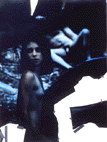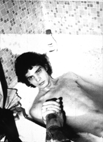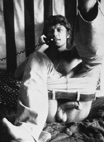 Bill Henson, Untitled, type C
photographs, adhesive tape, pins glassine, 120.0x90.3
cm,1995-96
|
Spilling from a large manila envelope onto the table
in the gallery office, Robert Mapplethorpe's modest black
and white polaroid photographs appeared like someone's
snapshots: images of friends, lovers and details from
life captured with intimacy and even a certain innocence.
And while I didn't see the photographs framed and
displayed on the wall (alongside later, larger images),
viewing them so intimately allowed the opportunity to
contrast them with Bill Henson's monumental montages,
theatrically installed in the main gallery. The work
of these two photographers seems to have almost nothing
in common except that they both, sometimes, produce
images of the human body and most of the time it's naked.
Henson's works from 1995-96 are brooding, cinematic in
scale and affect, at times erotic in a voluptuous way,
self- consciously evocative and alluring, luxurious when
viewed at close range and somehow harder and more brittle
when viewed from a distance. Mapplethorpe's black and
white polaroids from 1973-74, on the other hand, are
intimate in their delicacy and tonality, candid and
cheeky in their scale and affect, drawing the viewer into
the crisp and spontaneous instants of frisson.
|

Robert Mapplethorpe,
Self Portrait, unique black & white polaroid,
10.8x9.0 cm, 1973
|
Henson's work has always had a sultry feel. Even the
"crowd" images from 1979 are softly toned,
composed as though Henson's camera is moving across a sea
of faces and bodies, telephoto lens fixed, so that each
shot appears to bear the trace and slight blur of
movement at extreme close range. His untitled (and often
reproduced) series from 1977 depicts a slim naked
adolescent boy standing or reclined, looking asleep or
dead. Here Henson presents a body that is as tangible as
the softness of this boy's skin, and as ephemeral as his
shadowy surrounds. The softness of Henson's photos seems
to allow the intense sexual nature of his subjects
rather than create it. The realness of a naked pubescent
girl with the mere suggestion of pubic hair, or an
adolescent boy in shadowy contraposto with large hands
and tumescent penis, is constantly tugged away from us
into the realm of memory or imagination. In the 1995-96
works, apparently explicit sexual images generate
abstract relationships in the dreamscape that Henson
creates. The image of a couple fucking almost doesn't
even register on the brain. The naked torso of a girl
adjacent to the open legs of a naked boy refuses to
coalesce into a "complete" image; the boy's
torso is almost like the girl's memory image, or her body
a fantasy image of his. Henson's pictures seem mostly
either pre-coital or post-coital. The calmness that
pervades them is not so much foreboding as lingering, and
perhaps that's where the seduction lies. Mapplethorpe's
polaroids are seductive too. One image of crumpled white
bedsheets approaches the sublime in its simplicity,
others seduce the viewer with an effortless caprice. But
these works from the early seventies also convey a
certain crispness that would develop into what Thomas
Sokolowski refers to in his catalogue essay as
"glacial synopsis". The poloroids clearly
prefigure his later work, where the image gains a sexual
power precisely through the complex levels of detachment
which characterise the artist's portraits (of faces,
bodies and genitals), still lifes, and his disciplined
composition.1
A self portrait of the artist at age twenty-seven
stretched out in the bathtub is at first glance somehow
"wholesome", but Mapplethorpe's blank stare
just away from the camera is unsettling. In an untitled
photo a young blond guy sits on a bed wearing only a pair
of jeans which are pulled down to his thighs. His legs
are raised to show his almost-erect penis flopping
perpendicular to his testicles. This looks candid - he's
on the phone, he's wearing no jocks, a gold or silver
chain is askew across his chest, he's looking at
Mapplethorpe's camera - and it is sexy because of this
candour. But this image also has the formal traits of a
classic Mapplethorpe shot: the man's genitals are framed
by the edges of his belted denims and the bedspread on
which he sits; his foreshortened body is almost exactly
centrally placed within the image. What is most striking
about these images for me is that their immediacy (a
function of the polaroid process itself) communicates a
powerful sense of urgency. The imperfections and chemical
traces that appear in some of the polaroids would
disappear altogether from the artist's last silver
gelatin and platinum-on-linen photographs. But with these
polaroids it looks like all he wanted to do was to take
the picture. That urgency, now, is touching.
|

Bill Henson, Untitled,
type C photographs, adhesive tape, pins glassine,
255.4x193.0 cm,1995-96
|
If Henson's photographs (actually they are more than
photographs, they are monumental works) always operate on
the terms of distance, Mapplethorpe's polaroids are about
closeness and intimacy. Even Henson's crowd photos, or
the images of a young boy, or the smeared adolescent
bodies juxtaposed with baroque interiors, or the images
of suburban tiled roofs, or the New York series of
hookers and paramedics, all seem slightly remote. Too
vivid, remote as the news, these images are larger than
real scale (or simply real scale), but fictional because
they are big, intense in colour, more like giant movie
stills. Mapplethorpe, in contrast, in these early
polaroids, insinuates "photography" as a
mechanism of intimacy. Even though they are black and
white, their resonance is like a strong memory image.
Close and true, proferring memories of sensations that
many of us can easily recall: the feel of clean white
sheets against the skin, the feel of a cheek against a
man's furry belly, the strange and erotic sensation of an
erect penis - the feel of both the soft and tender outer
dermis and the internally hard blood-filled cavities of a
rigid dick, like the tense musculature of a forearm.
This is what makes Mapplethorpe's early work so
interesting. It is here that we might discover the
meaning of his work in relation to the man himself. Where
the later, more "famous" pictures are icy and
worldly, the early polaroids betray Mapplethorpe's
stature as a celebrity and a socialite artist. In a way
they are like Andy Warhol's first works, tentative,
somehow more honest than the outpouring of big museum
pictures, or society portraits which, frankly, are
produced as signs of the wealth and ego of the
commisioner.
|

Robert Mapplethorpe, Untitled,
unique black & white polaroid,10.8x9.0 cm, 1973
|
The "beauty" in these polaroids by
Mapplethorpe is in their innocence; created before the
hype, made when Robert's love (or desire, which will
suffice) for his subjects was perhaps at its most pure.
Some of them remind me of certain works by Felix
Gonzalez-Torres, but only because they speak about the
humanity of love and, of course, sex. What is beautiful
and moving is always that which is fleeting: a
particularly cute and disarming pose or gesture, an
expression of sly capriciousness, or else something
warmer like an exhalation of breath in a state of half
sleep. The intimacy of Mapplethorpe's polaroids suggests,
for instance, the beauty of long eyelashes on a young man
- a beauty that is acknowledged only by a few - and that
forms a kind of momentary flash of love. Despite the
differences in style, Hensen and Mapplethorpe both
express the essentially temporal quality of
"beauty". They frame the beautiful as that
event which is always too early or too late; speeding us
up or slowing us down for a moment that is too intangible
to grasp. Mixing the rhythms of timid anticipation and
languid reminiscence in their distinctive ways, Hensen
and Mapplethorpe give the sexualised body a truely
seductive duration, spreading the spectacle out through
its foreplay and afterglow.
Endnotes
1. That the polaroids contain the genesis
of Mapplethorpe's later work is curator Thomas
Sokolowski's very point. See his essay in the catalogue Right
From The Start: The Early Polaroids of Robert
Mapplethorpe, Roslyn Oxley9 Gallery, Sydney, 1996.
Thanks to Stephen O'Connell for his suggestions and
additions to this piece of writing.
Christopher Chapman
1996
|